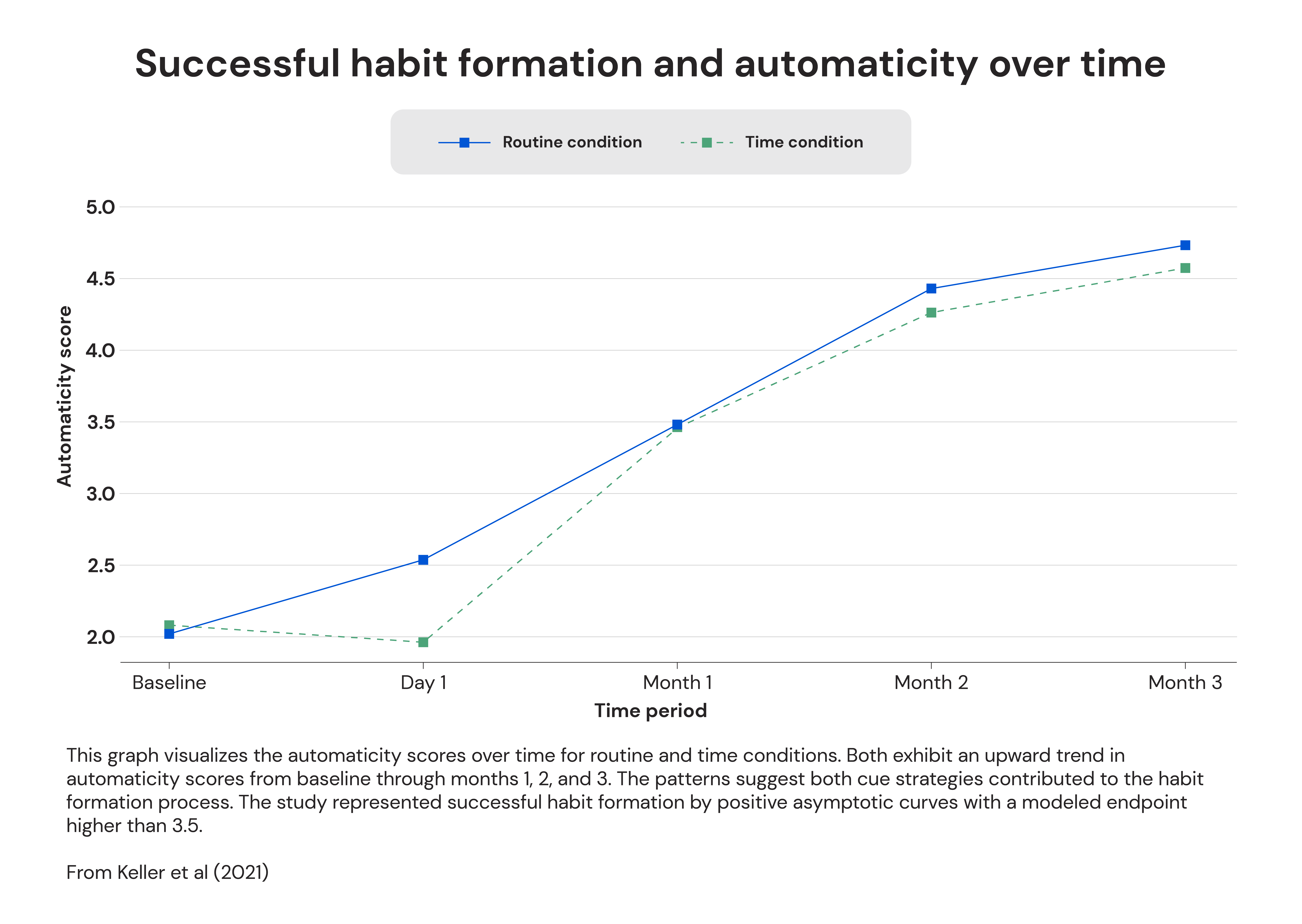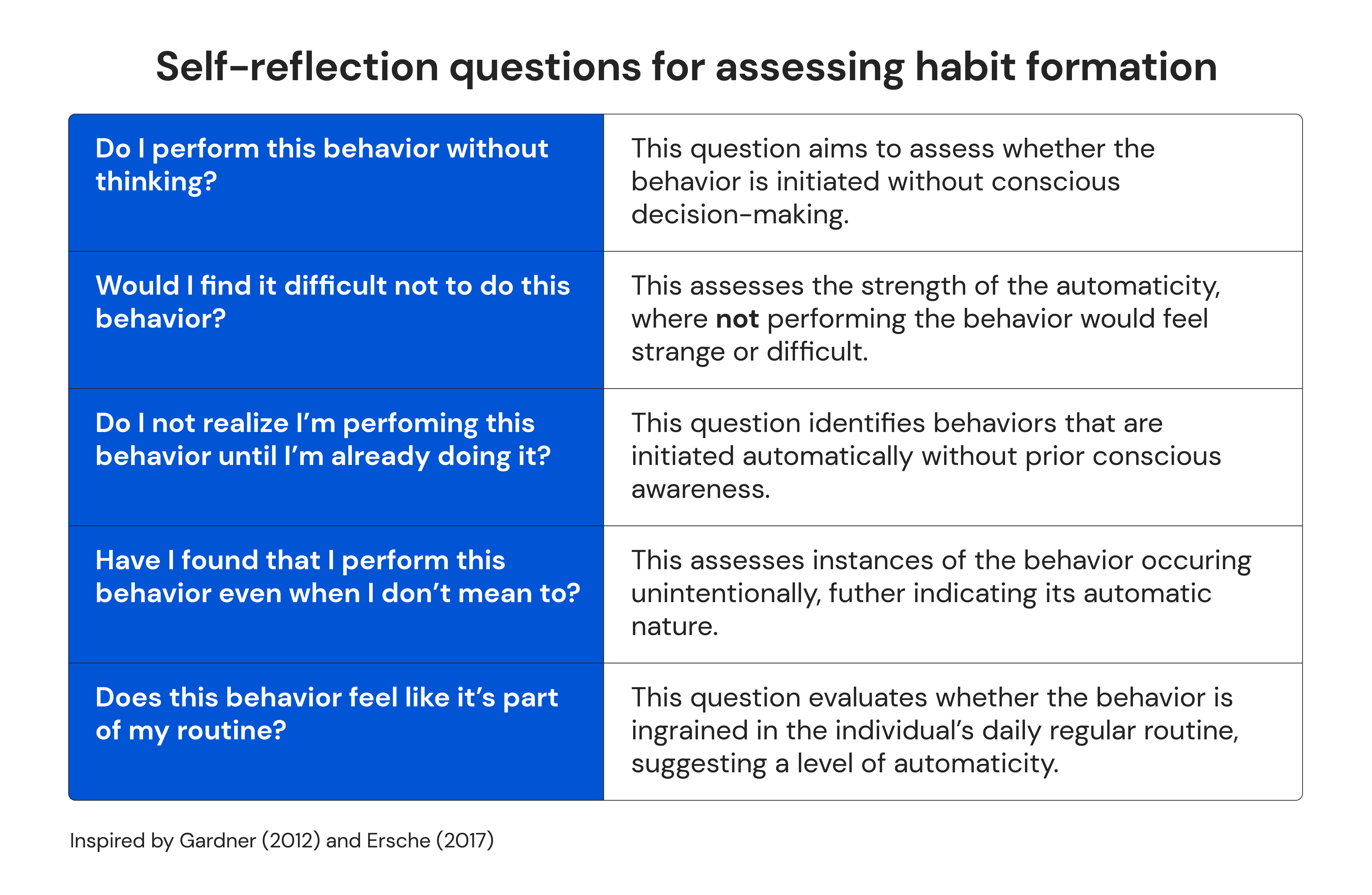Thus far in our series of articles on habits, we learned our days and nights consist of subconscious actions alongside our deliberate behaviors. For example, we might place our keys in the same spot upon returning home or immediately brush our teeth the moment we enter the bathroom in the morning. These subconscious behaviors — our habits — lessen our mental and cognitive load. Therefore, it would behoove us to use habits constructively to help us reach our goals.
Our second piece highlighted the importance of aligning our intentions with our habits. Many factors influence this alignment, ranging from childhood experiences to our financial means and personal lives. Essentially, we must know why we are trying to achieve our goals and what value these goals hold.
In the third article, we delved into the mechanics behind habit formation and uncovered the technical aspects of how habits form. It showed that not only do our intentions and desires matter, but also their specificity, order, and stability.
Now, our penultimate article in the series examines structuring our daily routines to support our desired habits. This involves understanding the specificity of our routines, optimizing them, and providing tips for embedding habits into our daily lives.
Let’s get into it!
Routines, habits, and the frameworks that help us succeed
Although intertwined, routines and habits are distinct. Routines are sequences of deliberate, conscious actions performed throughout the day or during specific, recurring events (e.g., weekends or holidays). For example, a morning routine might include exercising, showering, and eating breakfast. Each step is deliberately chosen and requires active participation to complete. Even if a routine becomes familiar over time or has habits within it, it still necessitates a conscious decision to follow through each day.
A habit, such as brushing your teeth the moment you enter the bathroom in the evening, unfolds with minimal conscious effort. Over time, this behavior becomes so embedded that it demands little to no deliberate intent to execute. Habits are automatic responses initiated by environmental or emotional cues, functioning mainly outside conscious awareness.
While the definitions of habits and routines draw obvious distinctions between the two (habits are automatic and subconscious, whereas routines are conscious and deliberate), the line separating habits and routines is hazier in practice. As mentioned previously, habits can be embedded within routines. So, your morning routine almost assuredly has multiple habits embedded within it. You consciously choose to get out of bed and walk into the bathroom, but washing your face and brushing your teeth may be completely habitual once you enter the bathroom. You make several conscious choices when selecting your outfit for the day, but the specific steps you take to put on your socks and shoes may be completely habitual. Driving to the office (hopefully) involves some conscious thought and awareness. Still, opening your car door, putting your coffee in a cupholder, starting the car, and shifting into reverse to begin your commute may be fully automatic and habitual. You get the point.
The line between “conscious” and “subconscious” can also be hazy for specific actions. Commuting is an excellent example. If you walk or drive the same route to work every day, I’m sure you’ve had the experience of walking out the door of your house or apartment, walking into the office, and not really being fully aware of much that happened between those two moments. You certainly weren’t acting wholly out of habit, with no conscious awareness or decision-making; otherwise, you’d bump into other pedestrians or hit another car. But you also weren’t fully locked in, aware, and consciously engaged with the world around you. Driving to work requires enough conscious awareness to be categorized as a routine. Still, it may require focus and conscious thought closer to a habit than, for example, filling out a challenging crossword puzzle.
Conversely, a habitual action doesn’t always have to be done subconsciously and with full automaticity. We’ve used tooth brushing as a frequent example of habitual action, but you probably have at least some conscious awareness of squeezing out the right amount of toothpaste, brushing each tooth well, etc. On some days, you may even be more mentally engaged with the process of brushing your teeth than the process of driving to work.
This is a long-winded way of illustrating that the boundary between habits and routines is hazier than the academic writing might suggest. Conscious awareness and automaticity of behavior aren’t strictly binary, with clear delineations between conscious/subconscious and automatic/non-automatic. Keep that in mind when you’re digesting and engaging with the content of this article. Suppose you catch yourself fretting over categorizing something as a habit versus a conscious routine to help support a habit. In that case, I’d simply encourage you not to get too hung up on the distinction since habits and routines can (and do) frequently bleed into each other.
With that out of the way, I want to first look at the important frameworks for using routines to build habits.
1) Accept the routines (and work) that come with building habits
When we try to condition a habit purposefully, we do so hoping that the new habit will support our goals and lifestyle. But what happens if you desire a habit without necessarily enjoying the routine that accompanies it? With routines, dichotomies can form when you want the outcome associated with a certain life, but you don’t actually enjoy living that life. Meaning, if you’re dreaming about having a weightlifter’s body, lifting weights will need to become a regular part of your life. You might run into trouble if you realize you don’t actually enjoy lifting weights.
We must accept that sometimes our dreams come with more hard work than we wanted.Reaching goals takes consistent effort. To be fair, some goals or habits come more naturally for certain people and are more baked into their lifestyle, family, friendships, or careers. That said, we can use our routines to develop more natural transitions to help our goals.
Therefore, the first and most important aspect of developing a solid routine is to understand (see: accept) that a lot of your routine might feel like working for the things that don’t happen naturally. This period can be challenging, but that’s precisely why these articles matter. It’s also why making tiny shifts rather than drastic overhauls can be helpful. Your efforts do not have to be all-encompassing or happen all at once, but we should adjust to the fact that some changes need to take place. Instead of resenting or huffing at them, embrace the process.
2) Give your routines and habits time (lots of it)
Researchers examining habits usually measure habit strength using a combination of self-report questionnaires and behavioral observations. Self-report instruments include scales such as the Self-Report Habit Index (SRHI), which assess the frequency and automaticity of behavior, i.e., how often and how automatically an individual engages in a particular behavior. They will then use the score to chart a path.
These graphs depict different patterns of habit formation: a negative asymptotic curve for non-successful habits, a quadratic curve for discontinuous progress, and a positive asymptotic curve for successful habits. These patterns illustrate the varying levels of automaticity over a period, with successful habits steadily increasing toward automaticity, plateauing as the behavior becomes a strong habit.

As you can see from the graph example, habit formation takes time. That amount of time also varies. The myth of developing habits in 21 days was born from a 1960 study that, at least in pop culture media, won’t go away. In the seminal study looking at habit formation, Lally et al found it took 18 to 245 days to create strong automaticity. In the Watson study we looked at in article 3, automaticity was achieved as early as six weeks. And in the Keller et al study, it took a median of 59 days for participants to reach peak automaticity.
To give you a better real-world example of an automaticity measure, the 2017 study by Fournier et al investigated the impact of time of day on health habit development. The study tracked 48 students for 90 days, requiring them to perform a psoas stretch daily, in the morning or evening. Based on the rate of habit strength improvement over those 90 days, further modeling projected that the morning group would achieve automaticity after an average of 105 days, while the evening group would achieve automaticity after an average of 154 days.

I will revisit this study when discussing optimal routines, but the main takeaway for now is that the time required for habit formation can vary –– not just among different habits, but also within the same habit. Purposefully conditioning a constructive habit is already impressive, so don’t get hung up on how fast you achieve automaticity. Instead focus on allowing sufficient time for the habit to become automatic and continually assessing whether automaticity has occurred. You shouldn’t beat yourself up if a new habit hasn’t become automatic within a month. It usually takes several months to condition a new habit. So, approach new habits with that expectation and a dash of patience.
3) Use routines to assist cue stability and supportive context
In our earlier article on habit formation, we explored stability and specificity through the example of brushing your teeth as soon as you enter the bathroom in the evening. The bathroom serves as the environmental cue, and entering the bathroom acts as an action cue. Additionally, the time of day may also function as an environmental cue. The habit cue was in a fixed environment, which is straightforward and easily repeated. This scenario represents an ideal stable cue, likely to succeed when coupled with strong intentions and desire.
However, cues are not always straightforward, and not all desired actions or habits are easy to execute. This is where routines can be crucial in supporting habit formation at a different level. Routines — sequences of actions we regularly follow — can bridge the gap. They provide structure and predictability, helping integrate new habits into our daily lives. For example, to incorporate exercise into your daily routine, you can set a specific time and sequence of actions to build habit strength. This could involve preparing your workout clothes the night before or having a post-workout meal waiting for you after your training. These small preparatory actions reinforce the intention to exercise, making the transition from routine to cue to action more seamless..
Routines also provide flexibility in changing environments when stable cues are absent. This means that even when the established environment shifts, our actions can stay the same, ensuring continuity in the actions we hope to be part of habits. For example, maintaining a walking routine after dinner (even if there isn’t the same cue stability) can be effective for action stability, whether at home or on vacation.
The takeaway is to view routines as opportunities to support the habits you’re working to establish rather than trying to develop a habit in isolation. By creating a supportive system, you significantly enhance your chances of success.
Are there optimal routines or styles of building habits?
Now that we’ve established a fundamental understanding of routines, let’s delve into optimization. Is there a difference between time-based and routine-based habit formation? Is it better to stack or nudge? While these questions might sound a bit like clickbait, these are the very questions researchers themselves attempt to examine.
The way we condition habits — how, when, and where — plays a crucial role, especially concerning cue context. Specificity is key. Studies explore various strategies for habit formation to determine if there’s an optimal method, such as:
- Time-based habits: Anchor habits to specific times or times of day.
- Routine-based habits: Establish a fixed sequence of actions for consistent habit development.
- Sequence-based habits: Stack new habits onto established ones for optimized growth.
- Reward-based habits: A focus on using rewards to reinforce behavior and habit formation.
One could argue that all these strategies could be employed simultaneously and that habit research should be stacked for a super meta approach. Without delving too deeply into the nuances, let’s see if we glean something to apply to the real world.
Let’s start by examining a randomized controlled trial by Keller et al that looked at the difference between anchoring nutrition habits around routine-based or time-based cues. It selected a group of 192 adults ranging from 18 to 77 years old. Upon enrollment, participants were randomized into two groups: one that used routine-based cue planning and another that used time-based cue planning. Participants selected a nutrition-related behavior they wanted to integrate into their daily routines or schedules at specific times. For instance, some drank a glass of water or ate a portion of fruit at a fixed time each day (e.g., at 12:00 pm), while others consumed their selected food item in conjunction with a daily routine, such as having a tablespoon of linseed oil at breakfast.
The follow-up period was 84 days, based on daily self-reporting scores on enactment of their selected nutrition behavior and evaluation of automaticity. Automaticity was achieved after a median time of 59 days.

From this study, we can see that both of these approaches worked to form their habits. You could argue that routine-based strategies had a slight edge over time-based, but not dramatically. In contrast, the study mentioned earlier by Fournier et al examined the impact of stretching in the morning versus the evening. It found a notable difference of nearly 50 days in achieving automaticity between morning and evening stretchers (but remember those were modeled results).
Recall from the third article in our series that the Judah study looked at incorporating flossing after an established habit, versus introducing a new habit without the foundation of an existing habit (habit stacking).
From all of this, is it possible to advocate for the best approach?
The evidence also suggests that forming certain habits when well-rested may be more effective than attempting them later in the evening. Stacking a new habit with an existing one also seems logical. However, the success of this approach depends on a variety of factors, from the complexity of the habit to, ultimately, the individual. Like diet studies, where debates continue over low carb versus low fat or the optimal number of daily meals, I’m skeptical that a one-size-fits-all solution exists for habit formation.
Anecdotally, I find that the timing of my self-improvement efforts varies based on the activity and how it fits into my routine. Mentally intensive tasks are off the table after 10 p.m., but I can engage in physical recovery, food prep, or practice familiar music on an instrument. For physically demanding activities, I perform best earlier in the day. And so on.
It boils down to knowing your routines and understanding the habit formation techniques. It all returns to setting intentions and thoughtful planning. It’s about analyzing your routine and committing to integrating a new daily habit. There’s no universally perfect time of day for this; the key is to begin and keep moving forward.
With that said, I believe in the momentum of meshing routine with habits and then habits with other habits, leading us to a deeper conversation and tips about habit stacking.
Tips for integrating new habits or actions with other habits (habit stacking)
Adopting new habits should involve a logical approach and assessment of your current life situation. It’s important to consider your goals and if your current routine can accommodate them. There have been periods in my life when my schedule was so packed that adding anything brand new would have been unrealistic. However, those times did offer opportunities to optimize existing elements. For example, could I enhance my sleep hygiene or bulk prepare my weekly meals? Could I take fewer shopping trips?
While pursuing new or more ambitious goals (e.g., training for a marathon) might not always be feasible, there’s usually room to improve something. My approach to habit stacking and formation focuses on optimizing lifestyle rather than randomly adding new elements just to see what sticks.
1) Start small. It really does help
We’ve all made the mistake of drafting grand plans and life changes when starting with smaller steps would have been more practical. At its core, this approach is about paying attention to the smallest details of your goals and seizing opportunities for incremental victories. For example, aiming to lose 30 pounds quickly might not be realistic. A better start could be aiming for 5 pounds over a longer period. Even more simply, it could involve tracking your eating habits and focusing on a month of successful maintenance.
Ideally, you should aim for small goals accompanied by habits that support those goals. This can differ slightly from strict habit stacking (which I’ll discuss below) because this supportive system can occur at any time of day or week, within any routine, and contribute toward singular or multiple goals.
Supportive habits or routines, even when formed for separate occasions, can also aid in achieving your primary goal. For instance, developing a habit of taking a walk during lunch can enhance your overall well-being. If it also supports your goal of losing weight, it’s a bonus.
The point is to collect tiny wins where possible and have little habits contributing to the greater whole.
2) Stack rewards and support where possible
We’ve established that a routine needs to be logical, simple, and supportive of your goals. Equally important is incorporating rewards within your routine. Put simply, we’re less inclined to continue activities if we don’t enjoy them or recognize their value. Whether the rewards are external or intrinsic, the path becomes easier if the benefits are apparent. For instance, new shoes for meeting step goals or pride in improved test results from your doctor can be rewards.
However, sometimes navigating the realm of rewards can be complex, especially when the benefits aren’t immediately obvious. Some habits, routines, or goals bear more obvious wins. Take improving a performance-based activity, like cooking, as an example. The rewards are easy to see: not only does one’s skill and competency increase but there’s also the pleasure of enjoying delicious meals. Overcoming the initial learning curve in activities like cooking offers continuous, inherent rewards that can motivate ongoing effort.
But what if the reward isn’t so immediately apparent?
A study by Klib and Labudek examined the participants’ perceptions of habit strength when adding vegetables to their meals. The study acknowledged the reward of having a positive feeling about making healthy choices and identified context stability and consistent performance as the key factors in habit formation. However, diary entries revealed that despite the rewarding feeling, participants found it challenging to maintain enthusiasm for eating vegetables after having them the previous day. They felt, more or less, that they had fulfilled their vegetable quota. Despite that feeling, the participants still persisted due to the stable context cue and their routine, therefore continuing to include vegetables in their meals. They just weren’t always so happy about it.
This study shows that sometimes, the reward aspect can be more complicated. The “reward” might sometimes make you resentful or bored. While seeking rewards from our habits is important, examining our intention moderators and understanding the deeper reasons behind our habit-building efforts is equally crucial. More importantly, this study shows that even when the reward doesn’t feel as satisfying, maintaining consistency in our cues and routines is essential to building the habit, especially when desire and motivation wane.
Therefore, reward where you can, but develop a consistent routine that can keep you on track despite how you might feel in the moment.
3) Reduce friction by stacking supportive actions or habits for the main habit
One hiccup in habit formation is determining the most effective following action. You can think of habit stacking a lot like trying to balance items: stacking flat, straight objects is simpler than balancing round or irregularly shaped ones. For example, it might not be practical to stack a study habit immediately after a bedtime meditation. Bedtime meditation aims to create a calming and relaxed pre-bed state of mind, not one that is open, awake, and ready to absorb new material. Therefore, those two stacks would make for an odd and likely ineffective pairing. Routines and habits should seamlessly transition from one to the next, creating a harmonious flow. Ideally, they should stack from one to the next in a lovely sequence of events that make an efficient whole.
This study from Lee et al explores the interplay between conscious intentions and unconscious exercise habits. It highlights the impact of pre-exercise preparations, like setting out exercise clothes, on the transition from intention to actual physical activity. The study suggests these preparation actions strengthen the link between intending to exercise and then executing the action.

Taking multiple actions to support a single habit goal clarifies your pursuit of the goal. These actions can be small and simple, not necessarily requiring a significant effort. Some actions might evolve into habits, such as leaving shoes and an umbrella by the door. In contrast, others could be a one-time supportive measure, like purchasing appropriate footwear and clothing for walking in various weather conditions. This is particularly relevant if, as mentioned in our second article, weather is identified as a potential obstacle. Such preparation enables effective if-then planning, allowing for adjustments like, “If it rains, then I’ll use my new umbrella and waterproof boots to get in my post-dinner walk.”
All three of these tips aim to reduce friction and create opportunities to support your habits and routines and, ultimately, your overall goals.
Monitoring progress to achieve automatic habits
The final aspect of our routine article highlights the importance of measuring progress or conducting check-ins. It might seem challenging to track the progress of habits we aim to perform subconsciously. After all, we are working intensively to map out behaviors that work on our behalf subconsciously. How do we check that?
Fortunately, habit strength research often relies on self-reporting methods. Researchers typically use various tools, such as the Self-Report Habit Index (SRHI), to assess frequency, automaticity, and identity through questionnaires. These aim to determine whether an action is performed automatically, providing insight into effective self-monitoring techniques.
Despite potential concerns over subjectivity and self-awareness, there is good consistency in responses to this research. Much like with other studies that involve trying to monitor people (via self-monitoring) in the real world, we may quibble over the preciseness, but it remains a practical starting point for assessing real-world outcomes.
Below, I’ve included typical questions from these questionnaires to help guide your self-evaluation during the habit formation process.

These questions serve as examples to answer one ultimate question: has this action become automatic?
Various tracking methods are available for logging, from traditional pen and paper to digital apps, and are suitable for monitoring the success of a habit you’re working on. Your system should complement the goal and habit you’re focusing on. For instance, if your objective is to reduce body fat and cease mindless snacking, an app like MacroFactor could be ideal. It tracks macros and includes sections for habits and notes, allowing for daily reflections on successes and challenges.
Additionally, habit journals and goal-specific diaries (e.g., a sleep journal) can guide your progress. Other systems, like pill dispensers labeled for each day, can visually demonstrate adherence to a habit; the absence of a pill indicates that the routine was followed. And so on.
Take home
The structure of your daily life is pretty important for habit success. Your actions throughout the day, the rooms you visit in your home when you do things, and even your driving routes all play a part in achieving your goals and forming your habits.
It’s important not to go overboard in transforming every moment into a habit or routine, but aligning our daily movements with our goals can be beneficial. Ultimately, consistency and repeatability in our schedules are key to having subconscious actions working in our favor (remember, they can undoubtedly work antagonistically). Establishing these routines can be challenging, but we have found breaking them to be far more difficult. Thus, I encourage you to evaluate your weekday and weekend schedules to identify opportunities for creating new habits and optimizing your routine to help make your habits stick.
Homework assignment: stacking toward our habit goal
Thus far, in our homework series, we’ve covered how to identify constructive and counterproductive goals, how to find our “why” for the habits we desire to build, and the importance of specific cue identification and integration for our habit goal design.
Now, we will examine Casey and Riley’s days and optimize each movement to support it.
Case study 1: Increase physical activity via walking after dinner
Casey is a 44-year-old freelance graphic designer who works from home and wants to counteract a sedentary lifestyle by incorporating more physical activity into their daily routine. Their objective is to add a 30-minute walk after dinner each day.
List 4 supportive and reward actions (in routine or habits) for your overall goal
- I will buy a nice umbrella and waterproof shoes because I hate being uncomfortable when I walk.
- I found a new game that has step gamification. I won’t feel guilty about buying and using it during my walks.
- I will keep my kitchen clean, so I don’t feel guilty about walking first.
- I will drive to new places to walk sometimes so I don’t get bored of seeing the same things.
When will you know it’s automatic?: “When I put my plate in the kitchen and go for a walk without thinking about it.”
Case study 2: Eliminate high-calorie snacking while watching TV/streaming
Riley is a 30-year-old account manager who tends to snack on high-calorie food while watching TV or streaming movies. Riley’s goal is to eliminate this habit, hoping it will also help meet their goal of losing 20 pounds of fat.
List 4 supportive and reward actions (in routine or habits) for your overall goal
- I will not feel guilty about multiple trips to the store if I run out of fresh items to snack on.
- I’ve wanted this nice air fryer and will get it to make alternatives for my more high-calorie snacks.
- I will prepare snack bags on the weekend when I have more time to make better weekday choices.
- I will incorporate more protein in my snacks, like low-fat cheese sticks or edamame, rather than just carb snacks.
When will you know it’s automatic? “When I don’t grab a snack at all, or if I do, it is lower in calories.”
Your assignment:
At the end of each article, take a moment to document each insight lesson for your journey. For this article, try to answer the assignment questions that are also asked of our case study participants.
In this instance, how can you stack your actions and habits to support your overall goal? Can you see places where you can have more overt and fun rewards, not just intrinsic ones? What else can you consider putting into your routine to help you complete your habit goals?





